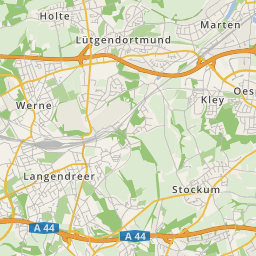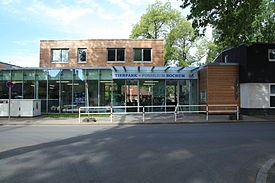












The 1,9 hectare large animal park is situated in the Stadtpark and shows around 3.800 animals of approximately 300 species.
The beginnings of Bochum's animal park go back to the founding of the club, Bochumer Tierparkfreunde e.V. on the 3rd of March 1933. Still in the same year, the first animal enclosures for deer, sheep and birds of prey were built in the Stadtpark at the Bismarck tower. A house for monkeys, birds and exotic animals followed. In 1939, the bear canyon and an aquarium house were added. Of the 300 showed animal species, were then already 100 fishes. Schools use the animal park as an addition to biology and drawing lessons.The animal park ringed birds on behalf of the ornithological station Helgoland. In the Second World War, bombs destroyed the park completely, thus the last remaining animals had to be given to the Wuppertal zoo and the ornithological institute Essen on the 24th of June 1943.
A comeback started with the predator trainer Lotte Walther, who moved into the animal park's winter quarters and made half of the income from an animal show available for the rebuilding of the zoo. The club Bochum Tierparkfreunde reconstituted itself new. Indigenous animals were to form the focus of the new, largely extended animal park. Zoological successes were achieved, especially with rearing wading birds, Urias and Northen gannets.
Eduard Stirnberg has been managing the development of the animal park Bochum since 1973. Under his guidance, the animal park became a relatively small but, scientific run zoo, whereby now a cross section of the whole fauna is being shown. In 1983 followed the construction of an operation and working building. In 1988 followed the construction of an aquarium and a terrarium house with a coral reef basin holding 170.000 litre water for the Blacktip reef sharks as a highlight. After the purchase of the fossil collection Helmut Leich, with over 400 fossils from the Solnhofener Jura, the fossilium was completed in 1996. On the 3rd of June 2006, the Nordseewelten opened. Part of this complex is apart from two North Sea theme aquariums, a basin, which holds 565.000 litres, for seals and Humboldt-penguins. Both species can be watched in clear seawater through large underwater panes. Affiliated is an accessible aviary for Ruffs, redshanks, avocetes as well as eider ducks and Goldeneyes, thus the animal park Bochum is continuing its earlier successes.
On the 23rd of May, Eduard Stirnberg opened officially further park constructions. New enclosures for coatis, ring-tailed lemurs, common marmosets, flamingoes, meerkats and squirrel monkeys were built. Visitors are now being greeted by a new glass cash desk building, which is connected to the aquarium. A new bee school with a real bee colony serves many schools as teaching place and the further education of apiculturists from the Ruhr area.
In addition, there are birds of prey, lynxs and a petting zoo with sheep, goats and ponies to be seen.
The Animal Park Bochum is a member of the European Zoo and Aquarium Association (EAZA), the Association of German Zoo Directors (VDZ), the Deutschen Tierpark-Gesellschaft (DTG), the association of German speaking Zoo Educators (VZP) and partner of the species protection foundation. it also takes part in different European conservation breeding programmes (EEP) and maintains a zoo school.
(The original text stems from an article of the Free Encyclopaedia Wikipedia
http://de.wikipedia.org/wiki/Tierpark_und_Fossilium_Bochum).